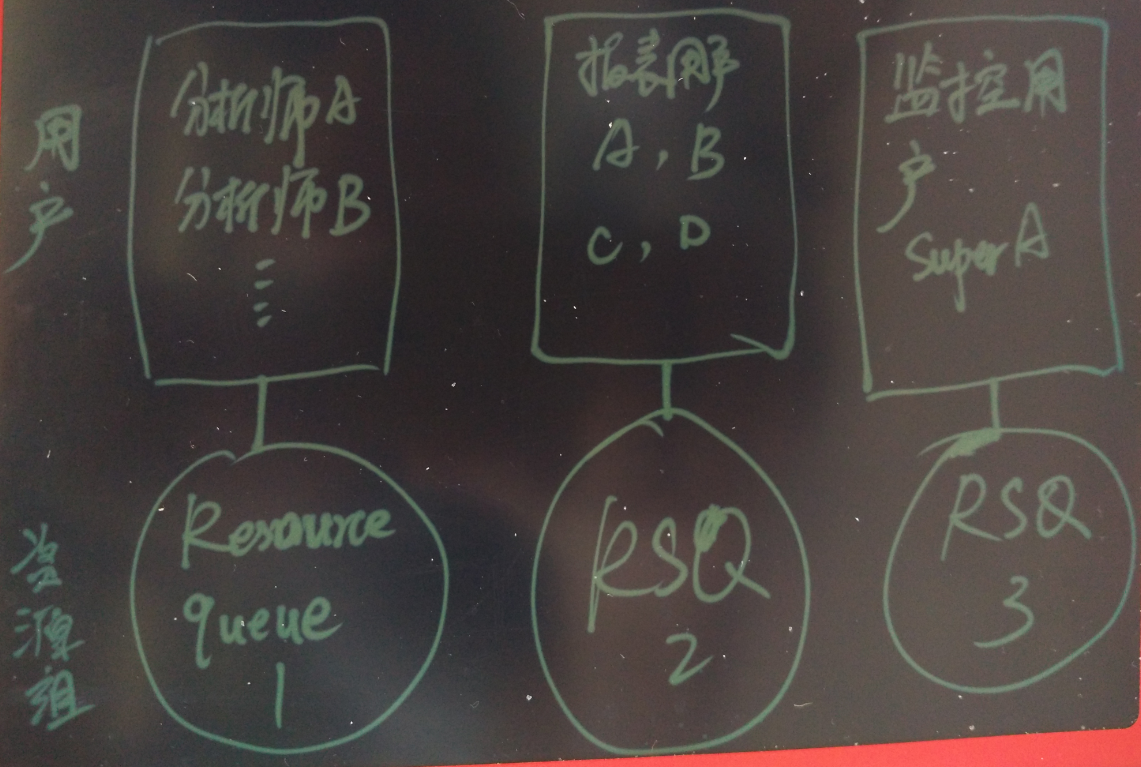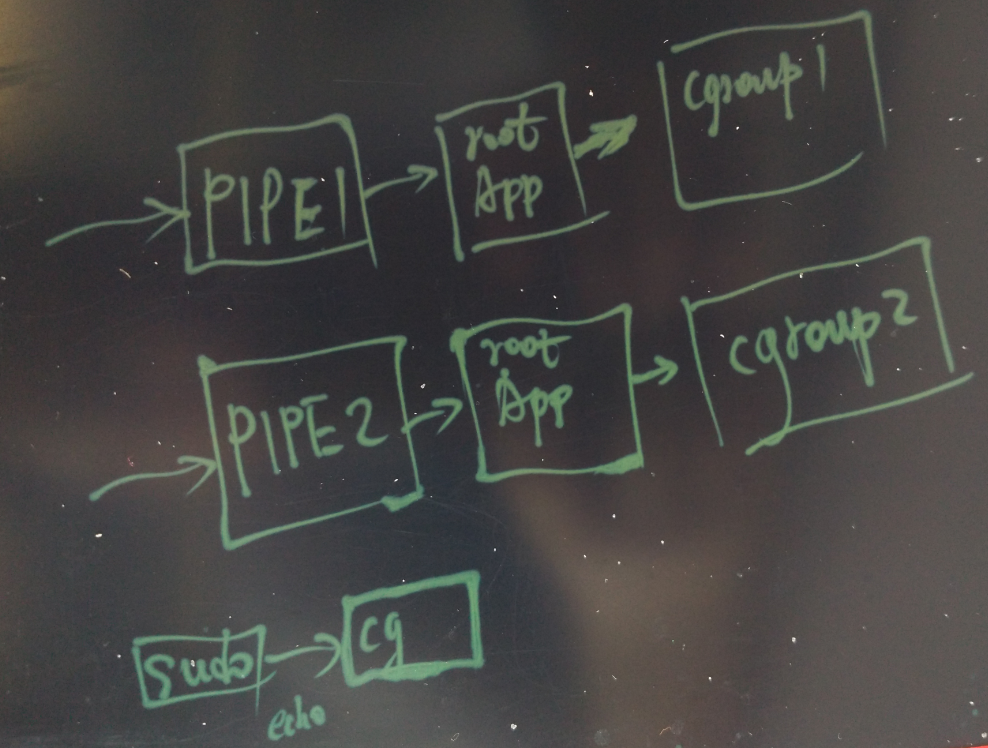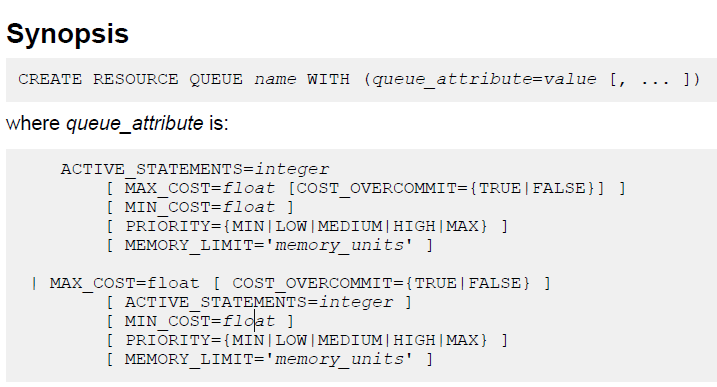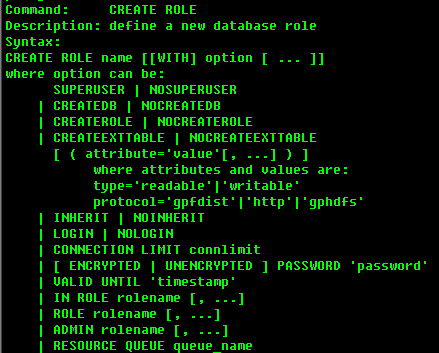摘要: 背景 Greenplum是一个MPP的数据仓库系统,最大的优点是水平扩展,并且一个QUERY就能将硬件资源的能力发挥到极致。 但这也是被一些用户诟病的一点,因为一个的QUERY就可能占光所有的硬件资源,所以并发一多的话,query相互之间的资源争抢就比较严重。 Greenplum资源隔
背景
Greenplum是一个MPP的数据仓库系统,最大的优点是水平扩展,并且一个QUERY就能将硬件资源的能力发挥到极致。
但这也是被一些用户诟病的一点,因为一个的QUERY就可能占光所有的硬件资源,所以并发一多的话,query相互之间的资源争抢就比较严重。
Greenplum资源隔离的手段
Greenplum为了降低并发query之间的资源争抢,设计了一套基于resource queue的资源管理方法。
每个resource queue定义了资源的使用或限制模式,根据用户的用途将用户指派给resource queue,这样就起到了资源管理的目的。
例如将分析师、跑报表的、ETL分为三用户。根据这三类用户的预期资源使用情况,以及任务的优先级,规划三类资源管理的队列。分别将三类用户和三类resource queue绑定,起到资源控制的作用。
resource queue的创建语法
支持的资源隔离类别
- active_statements, 该queue同时可以运行的query数量。
- max_cost,指资源组内所有正在运行的query的评估成本的最大值。
- cost_overcommit,当系统空闲时,是否允许该queue的query总cost超出设定的max_cost。
- min_cost 指低于该值的QUERY不计入该queue 的cost成本,也不排队,而是直接执行。
- priority , 用于平衡各个QUEUE之间的CPU争抢使用,分为5个等级,每个等级设定了响应的weight,间隔一定的时间判断使用的资源是否达到了weight,然后对该queue 的query使用pg_usleep进行抑制。
- mem_limit , 为队列中单个segment query(s)允许的最大statement(s)运行内存。
创建resource queue时必须设置active_statements与max_cost之一。
只有超级用户能创建和修改resource queue。
resource queue用法举例
创建两个资源队列,指派给两个用户(一个资源队列可以指派给多个用户)。
postgres=# create resource queue min with (active_statements=3, priority=min);
CREATE QUEUE
postgres=# create resource queue max with (active_statements=1, priority=max);
CREATE QUEUE
postgres=# create role max login encrypted password '123' resource queue max;
CREATE ROLE
postgres=# create role min login encrypted password '123' resource queue min;
CREATE ROLE
Greenplum资源隔离的相关代码
src/include/catalog/pg_resqueue.h
#define PG_RESRCTYPE_ACTIVE_STATEMENTS 1 /* rsqcountlimit: count */
#define PG_RESRCTYPE_MAX_COST 2 /* rsqcostlimit: max_cost */
#define PG_RESRCTYPE_MIN_COST 3 /* rsqignorecostlimit: min_cost */
#define PG_RESRCTYPE_COST_OVERCOMMIT 4 /* rsqovercommit: cost_overcommit*/
/* start of "pg_resourcetype" entries... */
#define PG_RESRCTYPE_PRIORITY 5 /* backoff.c: priority queue */
#define PG_RESRCTYPE_MEMORY_LIMIT 6 /* memquota.c: memory quota */
接下来我挑选了CPU的资源调度进行源码的分析,其他的几个本文就不分析了。
CPU的资源隔离
src/backend/postmaster/backoff.c
五个CPU优先级级别,以及对应的weight(可通过gp_adjust_priority函数调整当前query的weight)。
typedef struct PriorityMapping
{
const char *priorityVal;
int weight;
} PriorityMapping;
const struct PriorityMapping priority_map[] = {
{"MAX", 1000000},
{"HIGH", 1000},
{"MEDIUM", 500},
{"LOW", 200},
{"MIN", 100},
/* End of list marker */
{NULL, 0}
};
单个进程的资源使用统计信息数据结构
/**
* This is information that only the current backend ever needs to see.
*/
typedef struct BackoffBackendLocalEntry
{
int processId; /* Process Id of backend */
struct rusage startUsage; /* Usage when current statement began. To account for caching of backends. */
struct rusage lastUsage; /* Usage statistics when backend process performed local backoff action */
double lastSleepTime; /* Last sleep time when local backing-off action was performed */
int counter; /* Local counter is used as an approx measure of time */
bool inTick; /* Is backend currently performing tick? - to prevent nested calls */
bool groupingTimeExpired; /* Should backend try to find better leader? */
} BackoffBackendLocalEntry;
单个segment或master内所有进程共享的资源使用统计信息数据结构
/**
* There is a backend entry for every backend with a valid backendid on the master and segments.
*/
typedef struct BackoffBackendSharedEntry
{
struct StatementId statementId; /* A statement Id. Can be invalid. */
int groupLeaderIndex; /* Who is my leader? */
int groupSize; /* How many in my group ? */
int numFollowers; /* How many followers do I have? */
/* These fields are written by backend and read by sweeper process */
struct timeval lastCheckTime; /* Last time the backend process performed local back-off action.
Used to determine inactive backends. */
/* These fields are written to by sweeper and read by backend */
bool noBackoff; /* If set, then no backoff to be performed by this backend */
double targetUsage; /* Current target CPU usage as calculated by sweeper */
bool earlyBackoffExit; /* Sweeper asking backend to stop backing off */
/* These fields are written to and read by sweeper */
bool isActive; /* Sweeper marking backend as active based on lastCheckTime */
int numFollowersActive; /* If backend is a leader, this represents number of followers that are active */
/* These fields are wrtten by backend during init and by manual adjustment */
int weight; /* Weight of this statement */
} BackoffBackendSharedEntry;
/* In ms */
#define MIN_SLEEP_THRESHOLD 5000
/* In ms */
#define DEFAULT_SLEEP_TIME 100.0
通过getrusage()系统调用获得进程的资源使用情况
/* Provide tracing information */
PG_TRACE1(backoff__localcheck, MyBackendId);
if (gettimeofday(¤tTime, NULL) < 0)
{
elog(ERROR, "Unable to execute gettimeofday(). Please disable query prioritization.");
}
if (getrusage(RUSAGE_SELF, ¤tUsage) < 0)
{
elog(ERROR, "Unable to execute getrusage(). Please disable query prioritization.");
}
资源使用换算
if (!se->noBackoff)
{
/* How much did the cpu work on behalf of this process - incl user and sys time */
thisProcessTime = TIMEVAL_DIFF_USEC(currentUsage.ru_utime, le->lastUsage.ru_utime)
+ TIMEVAL_DIFF_USEC(currentUsage.ru_stime, le->lastUsage.ru_stime);
/* Absolute cpu time since the last check. This accounts for multiple procs per segment */
totalTime = TIMEVAL_DIFF_USEC(currentTime, se->lastCheckTime);
cpuRatio = thisProcessTime / totalTime;
cpuRatio = Min(cpuRatio, 1.0);
changeFactor = cpuRatio / se->targetUsage; // 和priority的weight有关,
// 和参数gp_resqueue_priority_cpucores_per_segment有关, double CPUAvailable = numProcsPerSegment(); 有关,
// se->targetUsage = (CPUAvailable) * (se->weight) / activeWeight / gl->numFollowersActive;
le->lastSleepTime *= changeFactor; // 计算是否需要sleep
if (le->lastSleepTime < DEFAULT_SLEEP_TIME)
le->lastSleepTime = DEFAULT_SLEEP_TIME;
超出MIN_SLEEP_THRESHOLD则进入休眠
memcpy( &le->lastUsage, ¤tUsage, sizeof(currentUsage));
memcpy( &se->lastCheckTime, ¤tTime, sizeof(currentTime));
if (le->lastSleepTime > MIN_SLEEP_THRESHOLD) // 计算是否需要sleep
{
/*
* Sleeping happens in chunks so that the backend may exit early from its sleep if the sweeper requests it to.
*/
int j =0;
long sleepInterval = ((long) gp_resqueue_priority_sweeper_interval) * 1000L;
int numIterations = (int) (le->lastSleepTime / sleepInterval);
double leftOver = (double) ((long) le->lastSleepTime % sleepInterval);
for (j=0;j<numIterations;j++)
{
/* Sleep a chunk */
pg_usleep(sleepInterval); // 休眠
/* Check for early backoff exit */
if (se->earlyBackoffExit)
{
le->lastSleepTime = DEFAULT_SLEEP_TIME; /* Minimize sleep time since we may need to recompute from scratch */
break;
}
}
if (j==numIterations)
pg_usleep(leftOver);
}
}
除了前面的休眠调度,还需要考虑当数据库空闲的时候,应该尽量使用数据库的资源,那么什么情况下不进入休眠呢?
/**
* Under certain conditions, we want to avoid backoff. Cases are:
* 1. A statement just entered or exited
* 2. A statement's weight changed due to user intervention via gp_adjust_priority()
* 3. There is no active backend
* 4. There is exactly one statement
* 5. Total number valid of backends <= number of procs per segment(gp_resqueue_priority_cpucores_per_segment 参数设置)
* Case 1 and 2 are approximated by checking if total statement weight changed since last sweeper loop.
*/
如何调整正在执行的query的weight
当正在执行一个query时,如果发现它太占资源,我们可以动态的设置它的weight。
当一个query正在执行时,可以调整它的priority
postgres=# set gp_debug_resqueue_priority=on;
postgres=# set client_min_messages ='debug';
查询当前的resource queue priority
postgres=# select * from gp_toolkit.gp_resq_priority_statement;
rqpdatname | rqpusename | rqpsession | rqpcommand | rqppriority | rqpweight | rqpquery
------------+------------+------------+------------+-------------+-----------+--------------------------------------------------------
postgres | digoal | 21 | 1 | MAX | 1000000 | select pg_sleep(1000000) from gp_dist_random('gp_id');
postgres | digoal | 22 | 1 | MAX | 1000000 | select pg_sleep(1000000) from gp_dist_random('gp_id');
postgres | digoal | 23 | 1 | MAX | 1000000 | select pg_sleep(1000000) from gp_dist_random('gp_id');
postgres | digoal | 24 | 1 | MAX | 1000000 | select pg_sleep(1000000) from gp_dist_random('gp_id');
postgres | digoal | 25 | 1 | MAX | 1000000 | select pg_sleep(1000000) from gp_dist_random('gp_id');
postgres | digoal | 26 | 65 | MAX | 1000000 | select * from gp_toolkit.gp_resq_priority_statement;
(6 rows)
设置,可以直接设置priority的别名(MIN, MAX, LOW, HIGH, MEDIAM),或者使用数字设置weight。
postgres=# select gp_adjust_priority(21,1,'MIN');
LOG: changing weight of (21:1) from 1000000 to 100
gp_adjust_priority
--------------------
1
(1 row)
postgres=# select * from gp_toolkit.gp_resq_priority_statement;
rqpdatname | rqpusename | rqpsession | rqpcommand | rqppriority | rqpweight | rqpquery
------------+------------+------------+------------+-------------+-----------+--------------------------------------------------------
postgres | digoal | 21 | 1 | MIN | 100 | select pg_sleep(1000000) from gp_dist_random('gp_id');
600是一个非标准的priority,所以显示NON-STANDARD
postgres=# select gp_adjust_priority(21,1,600);
postgres=# select * from gp_toolkit.gp_resq_priority_statement;
rqpdatname | rqpusename | rqpsession | rqpcommand | rqppriority | rqpweight | rqpquery
------------+------------+------------+------------+--------------+-----------+--------------------------------------------------------
postgres | digoal | 21 | 1 | NON-STANDARD | 600 | select pg_sleep(1000000) from gp_dist_random('gp_id');
代码如下
/**
* An interface to re-weigh an existing session on the master and all backends.
* Input:
* session id - what session is statement on?
* command count - what is the command count of statement.
* priority value - text, what should be the new priority of this statement.
* Output:
* number of backends whose weights were changed by this call.
*/
Datum
gp_adjust_priority_value(PG_FUNCTION_ARGS)
{
int32 session_id = PG_GETARG_INT32(0);
int32 command_count = PG_GETARG_INT32(1);
Datum dVal = PG_GETARG_DATUM(2);
char *priorityVal = NULL;
int wt = 0;
priorityVal = DatumGetCString(DirectFunctionCall1(textout, dVal));
if (!priorityVal)
{
elog(ERROR, "Invalid priority value specified.");
}
wt = BackoffPriorityValueToInt(priorityVal);
Assert(wt > 0);
pfree(priorityVal);
return DirectFunctionCall3(gp_adjust_priority_int, Int32GetDatum(session_id),
Int32GetDatum(command_count), Int32GetDatum(wt));
}
通过cgroup细粒度控制query的资源使用
前面讲的是Greenplum通过自带的resource queue来控制资源使用的情况,但是Greenplum控制的资源种类有限,有没有更细粒度的控制方法呢?
如果要进行更细粒度的控制,可以考虑使用cgroup来隔离各个query的资源使用。
可以做到对cpu, memory, iops, network的细粒度控制。
做法也很简单,
首先要在所有的物理主机创建对应的cgroup,例如为每个资源分配几个等级。
- cpu: 分若干个等级
- memory: 分若干个等级
- iops: 分若干个等级
- network: 分若干个等级
然后获得会话对应的所有节点的backend pid,将backend pid move到对应的cgroup即可。
祝大家玩得开心,欢迎随时来阿里云促膝长谈业务需求 ,恭候光临。
阿里云的小伙伴们加油,努力做 最贴地气的云数据库 。


